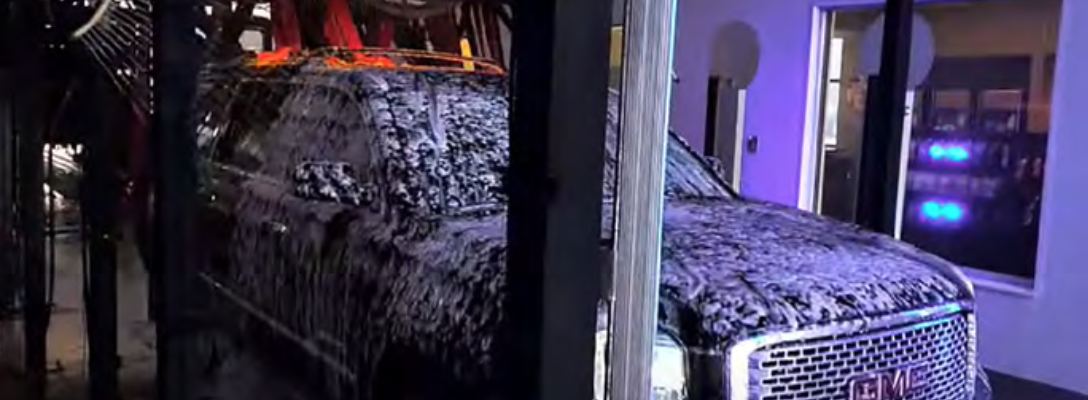The Formula for Success in Carwash Chemicals
By Angela Altass
Chemicals are an important part of the carwash business, and the chemistry behind the products continues to evolve.
“The last 10-15 years have seen an explosion of extra service or finishing products that have helped to drive the cost of a top package as high as $25 in some areas,” says Stuart Hulsey, R&D manager technical services, ZEP Vehicle Care. “Along with this increase in the average top package price has been a corresponding increase in revenue per car. There have also been some creative product bundling ideas resulting in what the industry refers to as processes.”
A process involves a specific combination of cleaning solutions followed by a combination of finishing products that are sold as a marketing package and result in an increased average cost per wash and increased revenue per car, explains Hulsey.

Hulsey says that ZEP has been very successful in “bundling their Armor All Professional Extreme Shine Wax, their Rain-X Complete Surface Protectant, and their Armor All Professional Ceramic Seal.” Providing an unsurpassed shine, just waxed feel, and extended protection.
Carwash owners should take the time to attend industry trade shows, such as the International Car Wash Association’s annual carwash show, advises Hulsey.
“We all know the show has, unfortunately, had to be cancelled or postponed this year (due to COVID-19) but these shows are great venues to connect with a wide range of industry experts to learn all you can about how to properly balance the chemistry in a carwash to provide a clean, dry and shiny result each and every wash,” notes Hulsey. “The best advice we can give is to regularly connect with your chemistry provider, who should be a well-informed consultant on the most advanced technologies.”
Sixty-three per cent of consumers say that the brand of soap used at a carwash is somewhat to extremely important in washing their vehicles, states Hulsey.
“Carwash owners want to make sure their site, including the product marketing they showcase, the products they use, and their image, stay fresh and attractive,” says Hulsey. “It would help to regularly apply the new product or wash package specials; to regularly update online, printed or on-site marketing materials; and possibly every two years consider more impactful product and service changes. The backbone of the chemical systems, the application pumps, dispensers, and other equipment, could be used for a considerably longer period of time, mostly depending on the maintenance work that has been put into it.”
There have been several new, interesting carwash chemistry developments over the years, notes Steve Kelly, Kleen-Rite Corp.
“Ceramic sealants have been introduced by a number of the carwash chemical manufacturers,” says Kelly. “These ceramic sealants are gaining traction as more people are becoming aware of them. Equipment and systems have been developed to apply wax in the self-serve bay and ready to use car interior disinfectant/sanitizer is available as a step to combat bacteria and viruses.”
Challenges are always present in automated carwashes, says Tim Taylor, owner, The Cobra System.
“We are always trying to design a better, faster, and more cost-effective way to get the job done,” states Taylor. “In bug removal, we have learned that high pH chemicals for starting the cleaning process works best. Bugs, birds, oils, and wheels seem to be the biggest challenges. On a busy day, you don’t want to spend a lot of time using labour to get bugs off and cleaning rims.”
The three requirements to getting the job done when it comes to bug removal, says Taylor are chemicals, labour, and equipment.
“One of these is not necessary if you use the right chemicals and equipment, and that is labour, he says, adding that labour eats up profits, is not consistent and slows down processing cars on a busy day. “Using a high pH presoak and surfactant helps process more cars per hour. At The Cobra System, we are different because of how our customers apply heated chemicals at the point of application using our heated chemical tire applicators and heated bug towers. Adding some heat breaks down the organic materials much faster and more effectively while neutralizing any acid left on the vehicle surface. For best results to remove any organic materials, the chemical should be applied on areas needed before the car is wetted so the chemical will be drawn in like a sponge. If the car is wetted, there will be a dilution barrier, causing ineffectiveness for cleaning.”
When purchasing chemicals, Kelly Maria, key account manager, Mark VII Equipment Inc., cautions against choosing based on price.
“A drum cost means absolutely nothing,” states Maria. “One drum could cost $100 and another $200, but if you have to use triple the amount of the one that is $100, then the cost per car far exceeds what the higher priced drum was. Look at usage per car instead of drum price.”
Mark VII Equipment decided to get into the carwash chemical business a few years ago and continues to explore new formulas for its chemical line of products.
“One product I think is particularly worth mentioning is ShineTecs, which buffs the car with hand waxing quality that really makes it shine,” says Maria. “We have a lot of testimonials from customers who are using it and love the product.”
In the carwash industry, it’s always good to have new product offerings to stimulate the customer base and attract new customer opportunities, says Jack Bonow, assistant vice president of sales Canada & Central U.S., Cleaning Systems, Inc.
“Most notably over the past several years, carwash chemical manufacturers have focused on protection products,” says Bonow. “The most recent craze has been with ceramics formulated into super sealant and clear coat sealants, providing long-lasting protection and shine. CSI/Lustra has kept pace with these new product offers and often deviated from the herd to create more innovative and advanced technological formulations.”
CSI is introducing an innovative super sealant, ProSheild Polymer Protection, infused with CSI’s Apexamer Technology. This product goes beyond ceramics and provides a unique cross-linking or web-like application, giving surface protection from everyday elements and increasing a vehicle’s hydrophobicity, which is the ability to shed water and rain, he states.
“Not every carwash chemical is right for every location across the world,” notes Bonow. “Regions and cities differ, depending on seasonal weather patterns, hot and cold conditions, water quality, and environmental elements. In talking about cleaning solutions, these conditions have a dramatic effect on the ability for a product to perform. Some products are built to perform better when hard water is an issue, and others are best suited for environmental fallouts from agriculture, industrial, and commercial regions.”
Most chemical manufacturers make several cleaning detergents designed for various environmental conditions, methods of application, and types of car washing equipment, notes Bonow. Regarding chemical application or delivery systems, there are a lot of older wash units that could use upgrading, which could make a world of difference in performance, and efficiency states Bonow.
“First and foremost, I recommend an ongoing check of all the backroom pumps and chemical delivery systems,” he advises. “One bad pump can cause poor performance and customer dissatisfaction. There are many efficient delivery systems on the market today that, in the long run, can save the operator money and improve customer satisfaction.”
Whether it’s a tunnel, in-bay, or self-serve operation, it is good practice to regularly evaluate each application function to see if they are performing to expectations, says Bonow.
“This is what the customer sees and judges how good, or bad the wash experience was,” he comments. “Steady maintenance can make a big difference and keep repair costs down, but there are times when things wear out or are outdated and need to be upgraded. For example, there are more efficient types of foaming apparatuses on the market now to replace the old-style foam sticks and shower heads.”
Bonow also recommends examining chemical lines every few months, those coming from the products to the pumping units and then again out into the bay and replacing old and worn chemical lines with new ones.
“Carwash manufacturers, both in equipment and in chemicals, are continuously developing new and improved products to enhance the carwash experience as well as greater efficiencies,” notes Bonow. “If you haven’t done it already, maybe it’s time to evaluate your carwash, your customer base and develop a plan to upgrade where needed.”


